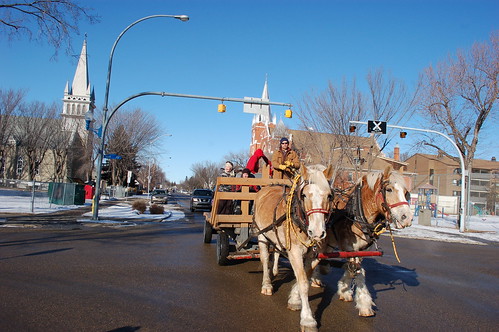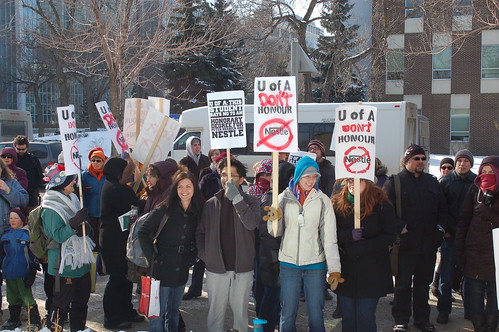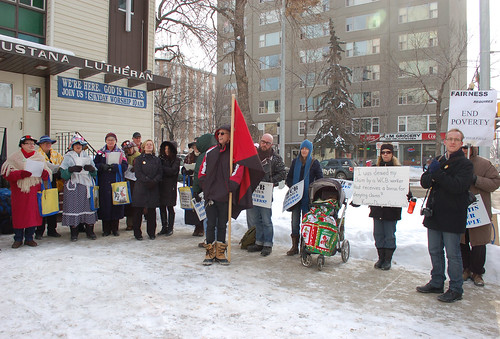Thoughts and musings from a writer, editor, photographer, activist, and musician in Edmonton, Alberta, Canada. I believe that faith and social action are intertwined in efforts to positively motivate change in the society around us. We need to be actively involved in our communities to try to effect this change locally and globally. I also love the local Arts scene. Warning: alternative perspectives and strong opinions ahead. Intimidated yet? Good - read on.
Sunday, March 25, 2012
Raise My Voice Becomes Radical Citizen Media
Wednesday, March 21, 2012
Introducing Friends of Church Street
The horse-drawn wagon depicted above is winding its way through Church Street. To the left is Queen of Martyrs Vietnamese Catholic Church, and on the right is Sacred Heart Church of the First Peoples.
Church Street is one of Edmonton's most valuable historic resources. Although not officially called that - yet - Church Street is located along and around 96 Street in the McCauley neighbourhood, part of the inner city which is currently undergoing revitalization efforts.
Friends of Church Street is a new organization seeking to promote the historical significance of the area. It all started in the fall of 2010 when I was a Community Animator for McCauley with Action for Healthy Communities. Part of my job was to encourage and facilitate residents in grassroots community initiatives. One such initiative was the McCauley Connects Coffeehouse, which regularly features local talent.
The other initiative came from a woman named Colleen Chapman, who also happens to share Volunteer Coordinator duties with me at Boyle McCauley News. Church Street was in the process of being honoured by the Edmonton Historical Society and Colleen thought it would be great to have a Church Street Fair in the summer of 2011.
Planning an event of this magnitude proved to be too much for just a few months, so the event ended up getting pushed ahead to 2013. However, in the meantime, Colleen gathered together a group of community members and boosters to form Friends of Church Street. I am the Communications Director, and in addition to planning the Fair, we seek to raise awareness of and attention towards the history, architecture, and importance of Church Street.
The City of Edmonton is indeed taking notice of just how important the area is. This article, published in the February 27 issue of the Edmonton Journal, reveals that the City may very well make the name Church Street official.
Church Street is a boost to both McCauley's revitalization and the City in general. There is a rich history behind many of the churches, and the architecture is spectacular. In fact, Church Street has put Edmonton in the Guinness Book of World Records - 96 Street still holds the record for the highest concentration of churches within the few blocks it spans.
We launched our website today and are also on Facebook and Twitter (@ChurchStreet96).
What are some of your ideas concerning Church Street? Any suggestions for the fair? Walking tours? Souvenirs? Contact us and get involved!
Wednesday, March 07, 2012
Freedom to Read is Freedom to Live
KONY 2012 and Activist Strategies
Friday, March 02, 2012
A Dubious Honour: Nestle Protest
An honorary degree is a very high accolade to bestow upon someone. Peter Brabeck-Letmathe, Chair of Nestle, received this honour yesterday from the University of Alberta.
The decision to award Brabeck-Letmathe in this way came with controversy since day one of it being announced. The outcry against the U of A's decision came to a head yesterday when a rally was held outside the Timms Centre for the Arts shortly before the ceremony was set to begin.
Breastfeeding advocates, almuni, experts in water security, students, parents, and professors spoke (in varying combinations,such as a breastfeeding advocate with five children of her own, and a professor who is an environmental specialist).
The bottom line was that Nestle has had a spotty record in its actions as a multinational corporation, particularly in two areas. First, by selling its baby formula to women in the Third World by saying it was better than breast milk. In these countries, water is scarce and often contaminated. Formula has to be mixed with water. Babies were getting sick and dying, and by the time the mothers realized what was wrong, their own breast milk had dried up.
The other thing is Nestle's treatment of water as a commodity. It views water as a foodstuff and is responsible for much of the waste that is bottled water.
One of the speakers raised some excellent questions, asking why precisely this person was chosen to receive an honorary degree instead of being recognized some other way. Why the highest honour a degree-granting institution can give?
The excellent turnout at the rally (I counted between 150-200 people at its peak) demonstrates that people are watching and people do care when it comes to the actions of the University of Alberta. The U of A has a history of excellence which would be painful to see overshadowed by it selling out to corporate interests.
Here is my photo set of the rally.
Thursday, March 01, 2012
Attention Please: WCB Injured Workers Rally
You're a worker. You get injured on the job. You make a claim to the Workers Compensation Board. However, your claim is denied. Or, you are met with a maze of paperwork around every corner and doctor's appointment.
Yesterday was the first of three days of protest of injured workers who say that their have been treated unfairly by the WCB. The rally was organized by the workers themselves with support from Occupy Edmonton.
The workers spoke, telling their stories amongst speeches from MLAs and provincial candidates, the songs of the Raging Grannies, and some insight from a local psychologist who has worked on WCB cases.
With a provincial election a couple of months away, the operations of the WCB may become an issue for discussion. The conclusion of everyone who spoke was that the system is broken and in need of an immediate Provincial investigation and reform. Although I personally have never had any dealings with the WCB, I was quite concerned with what I was hearing and think that the stories of these workers is good fodder for some investigative journalism.
Here are the rest of my photos.


